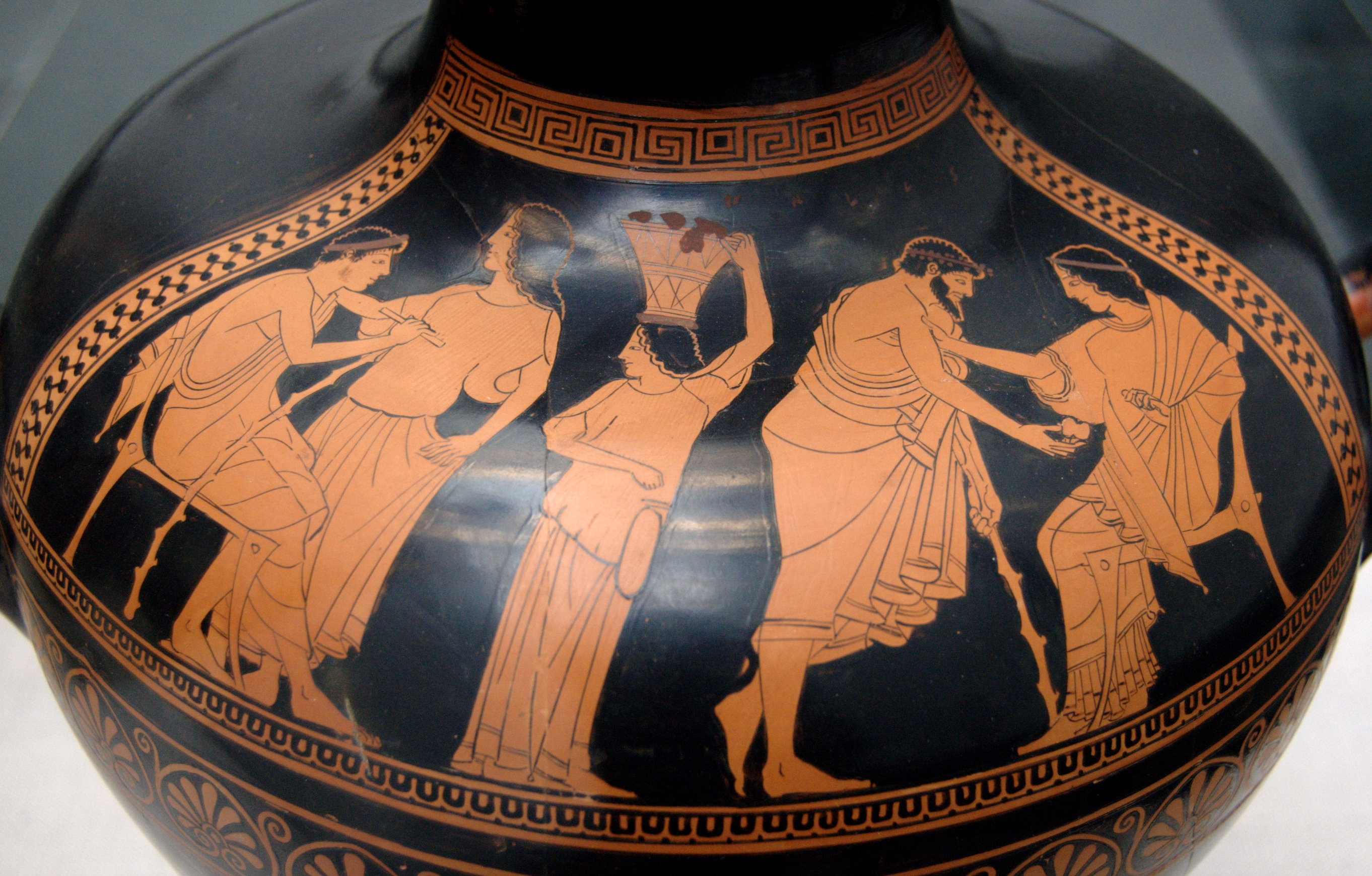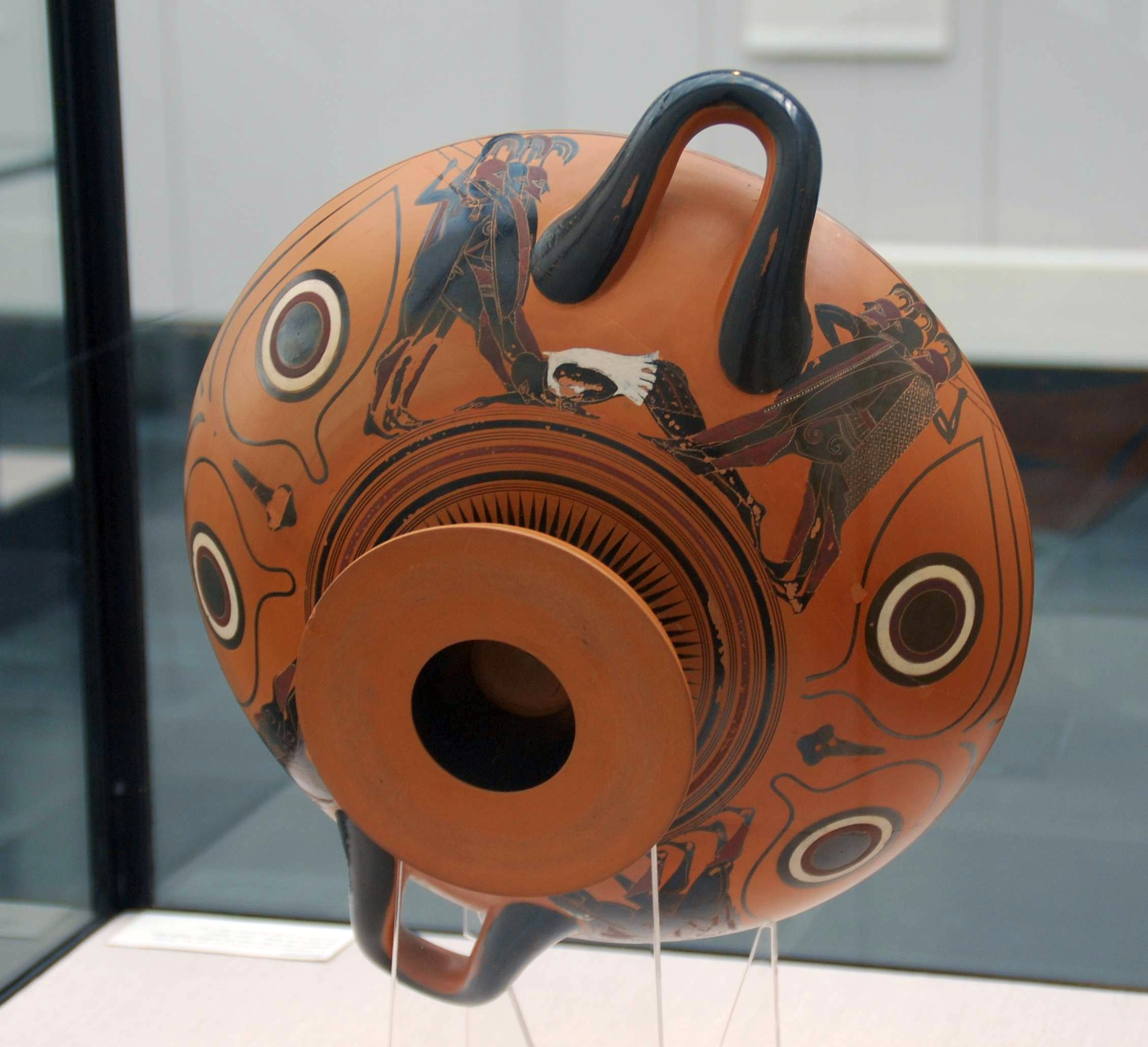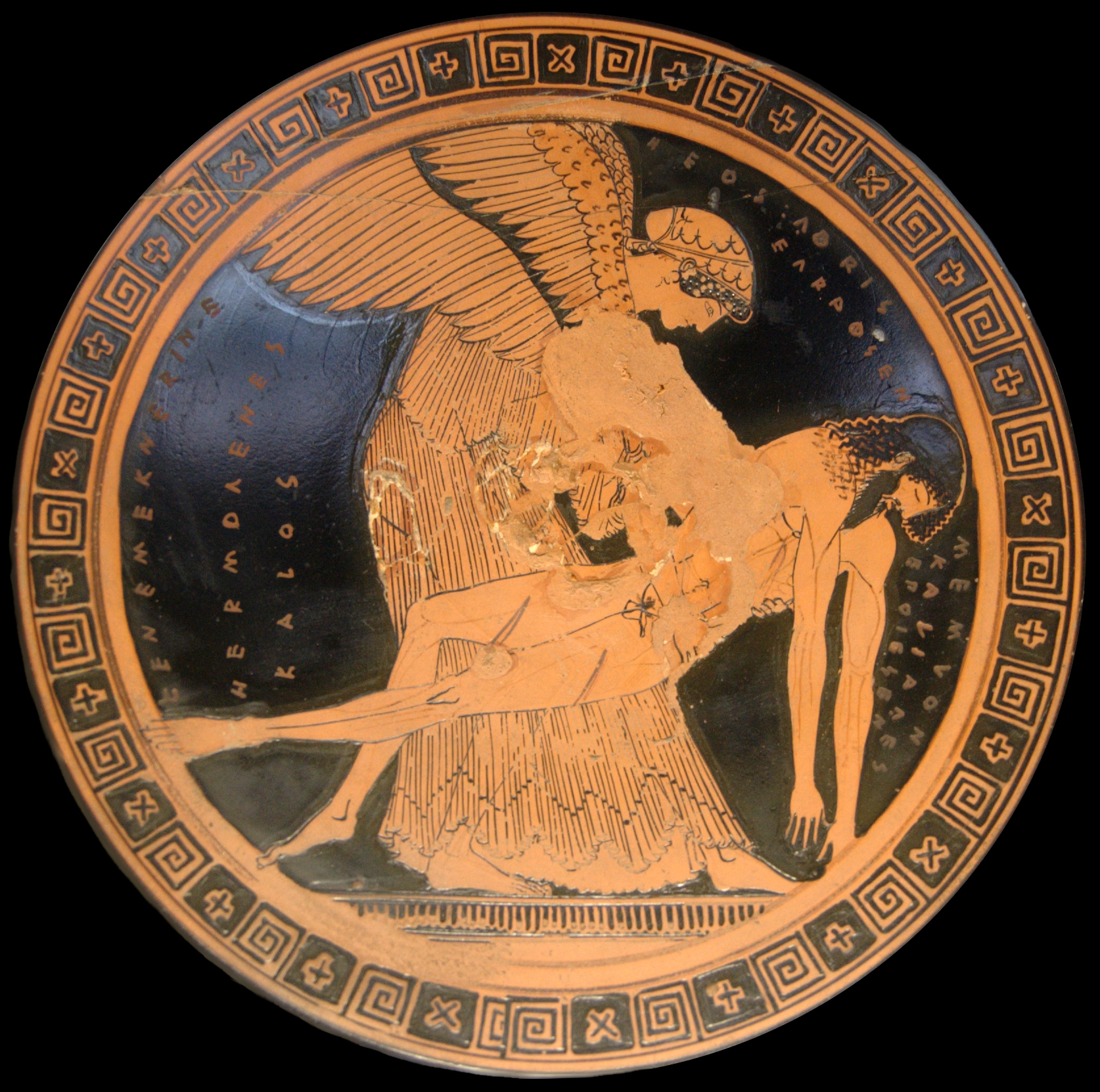|
Antiphon Painter
The Antiphon Painter was an Athenian vase painter of the early 5th century BC. He owes his name to a double Kalos inscription of Antiphon on the dinos stand in the Antique collection of Berlin (Inventory number F 2325). He was active between 500 and 475 BC in Athens as a painter of the red-figure style in the largest workshop of the 5th century. He learned his handicraft in the workshop of Euphronios and Onesimos. There he worked closely with them, the Kalmarer Painter and other painters. There are about 100 drinking containers of his (primarily kylikes) known to us. They almost exclusively depict the life of the aristocratic youth of Athens. They are shown as athletes, in symposia, in komos scenes, and with their horses or in arms. Representations of women – in particular Hetairai – are rare, as are mythological topics. When he depicts mythological subjects, they are usually the heroic acts of Herakles or Theseus. One of his bowls possibly refers to the Battle of Marathon ... [...More Info...] [...Related Items...] OR: [Wikipedia] [Google] [Baidu] |
Jumper With Weights Staatliche Antikensammlungen 2635
Jumper or Jumpers may refer to: Clothing *Jumper (sweater), a long-sleeve article of clothing; also called a top, pullover, or sweater **A waist-length top garment of dense wool, part of the Royal Navy uniform and the uniform of the United States Navy *Jumper (dress) (U.S. English; known elsewhere as a ''pinafore dress''), a sleeveless dress intended to be worn over a top or blouse People * Betty Mae Tiger Jumper (1923–2011), first female chief of the Seminole Tribe of Florida * Hunter Jumper (born 1989), American soccer player * John Jumper (Seminole chief) (1820–1896), principal chief of the Seminoles from 1849 to 1865 * John P. Jumper (born 1945), former Chief of Staff of the United States Air Force * William Jumper (1660–1715), Royal Navy officer Arts, media, and entertainment * ''Jumper'' (novel), a novel by Steven Gould ** ''Jumper'' (2008 film), a 2008 film adaptation of the novel ** ''Jumper: Griffin's Story'' (video game), a video game based on the film ** ''J ... [...More Info...] [...Related Items...] OR: [Wikipedia] [Google] [Baidu] |
Hetairai
Hetaira (plural hetairai (), also hetaera (plural hetaerae ), ( grc, ἑταίρα, "companion", pl. , la, hetaera, pl. ) was a type of prostitute in ancient Greece, who served as an artist, entertainer and conversationalist in addition to providing sexual service. Unlike the rule for ancient Greek women, hetairas would be highly educated and were allowed in the symposium. Summary Traditionally, historians of ancient Greece have distinguished between ''hetairai'' and ''pornai'', another class of prostitute in ancient Greece. In contrast to pornai, who provided sex for numerous clients in brothels or on the street, hetairai were thought to have had only a few men as clients at any one time, to have had long-term relationships with them, and to have provided companionship and intellectual stimulation as well as sex. For instance, Charles Seltman wrote in 1953 that "hetaeras were certainly in a very different class, often highly educated women". More recently, however, historia ... [...More Info...] [...Related Items...] OR: [Wikipedia] [Google] [Baidu] |
Ancient Greek Vase Painters
Ancient history is a time period from the beginning of writing and recorded human history to as far as late antiquity. The span of recorded history is roughly 5,000 years, beginning with the Sumerian cuneiform script. Ancient history covers all continents inhabited by humans in the period 3000 BCAD 500. The three-age system periodizes ancient history into the Stone Age, the Bronze Age, and the Iron Age, with recorded history generally considered to begin with the Bronze Age. The start and end of the three ages varies between world regions. In many regions the Bronze Age is generally considered to begin a few centuries prior to 3000 BC, while the end of the Iron Age varies from the early first millennium BC in some regions to the late first millennium AD in others. During the time period of ancient history, the world population was already exponentially increasing due to the Neolithic Revolution, which was in full progress. While in 10,000 BC, the world population stood at ... [...More Info...] [...Related Items...] OR: [Wikipedia] [Google] [Baidu] |
5th-century BC Deaths
The 5th century is the time period from 401 ( CDI) through 500 ( D) ''Anno Domini'' (AD) or Common Era (CE) in the Julian calendar. The 5th century is noted for being a period of migration and political instability throughout Eurasia. It saw the collapse of the Western Roman Empire, which came to an end in 476 AD. This empire had been ruled by a succession of weak emperors, with the real political might being increasingly concentrated among military leaders. Internal instability allowed a Visigoth army to reach and ransack Rome in 410. Some recovery took place during the following decades, but the Western Empire received another serious blow when a second foreign group, the Vandals, occupied Carthage, capital of an extremely important province in Africa. Attempts to retake the province were interrupted by the invasion of the Huns under Attila. After Attila's defeat, both Eastern and Western empires joined forces for a final assault on Vandal North Africa, but this campaign was ... [...More Info...] [...Related Items...] OR: [Wikipedia] [Google] [Baidu] |
Eye-cup
Eye-cup is the term describing a specific cup type in ancient Greek pottery, distinguished by pairs of eyes painted on the external surface. Description Classified as '' kylikes'' in terms of shape, eye-cups were especially widespread in Athens and Chalkis in the second half of the sixth century BC. The bowl of the eye-cup rests on a short squat foot; both sides are dominated by large painted pairs of eyes under arched eyebrows. The eyeballs are painted in silhouette style, later often filled with white paint or painted white on black. Some eyes are “female”, i.e. almond-shaped and without tear-ducts. Often, a stylized nose is placed centrally between the eyes. While used as a drinking vessel, due to the necessary inclination of the vessel, the cup with its painted eyes, the handles looking like ears and the base of the foot like a mouth, would have resembled a mask. Many of the vases also bear dionysiac imagery. The eyes are assumed to have served an apotropaic (evil-a ... [...More Info...] [...Related Items...] OR: [Wikipedia] [Google] [Baidu] |
Battle Of Marathon
The Battle of Marathon took place in 490 BC during the first Persian invasion of Greece. It was fought between the citizens of Athens, aided by Plataea, and a Persian force commanded by Datis and Artaphernes. The battle was the culmination of the first attempt by Persia, under King Darius I, to subjugate Greece. The Greek army inflicted a crushing defeat on the more numerous Persians, marking a turning point in the Greco-Persian Wars. The first Persian invasion was a response to Athenian involvement in the Ionian Revolt, when Athens and Eretria sent a force to support the cities of Ionia in their attempt to overthrow Persian rule. The Athenians and Eretrians had succeeded in capturing and burning Sardis, but they were then forced to retreat with heavy losses. In response to this raid, Darius swore to burn down Athens and Eretria. According to Herodotus, Darius had his bow brought to him and then shot an arrow "upwards towards heaven", saying as he did so: "Zeus, that it may b ... [...More Info...] [...Related Items...] OR: [Wikipedia] [Google] [Baidu] |
Theseus
Theseus (, ; grc-gre, Θησεύς ) was the mythical king and founder-hero of Athens. The myths surrounding Theseus his journeys, exploits, and friends have provided material for fiction throughout the ages. Theseus is sometimes described as the son of Aegeus, King of Athens, and sometimes as the son of the god Poseidon. He was raised by his mother, Aethra, and, upon discovering his connection to Aegeus, travels overland to Athens, having many adventures on the way. When he reaches Athens, he finds that Aegeus is married to Medea (formerly wife of Jason), who plots against him. The most famous legend about Theseus is his slaying of the Minotaur, half man and half bull. He then goes on to unite Attica under Athenian rule: the ''synoikismos'' ('dwelling together'). As the unifying king, he is credited with building a palace on the fortress of the Acropolis. Pausanias reports that after ''synoikismos'', Theseus established a cult of Aphrodite ('Aphrodite of all the People' ... [...More Info...] [...Related Items...] OR: [Wikipedia] [Google] [Baidu] |
Herakles
Heracles ( ; grc-gre, Ἡρακλῆς, , glory/fame of Hera), born Alcaeus (, ''Alkaios'') or Alcides (, ''Alkeidēs''), was a divine hero in Greek mythology, the son of Zeus and Alcmene, and the foster son of Amphitryon.By his adoptive descent through Amphitryon, Heracles receives the epithet Alcides, as "of the line of Alcaeus", father of Amphitryon. Amphitryon's own, mortal son was Iphicles. He was a great-grandson and half-brother (as they are both sired by the god Zeus) of Perseus, and similarly a half-brother of Dionysus. He was the greatest of the Greek heroes, the ancestor of royal clans who claimed to be Heracleidae (), and a champion of the Olympian order against chthonic monsters. In Rome and the modern West, he is known as Hercules, with whom the later Roman emperors, in particular Commodus and Maximian, often identified themselves. The Romans adopted the Greek version of his life and works essentially unchanged, but added anecdotal detail of their own, some ... [...More Info...] [...Related Items...] OR: [Wikipedia] [Google] [Baidu] |
Greek Mythology
A major branch of classical mythology, Greek mythology is the body of myths originally told by the Ancient Greece, ancient Greeks, and a genre of Ancient Greek folklore. These stories concern the Cosmogony, origin and Cosmology#Metaphysical cosmology, nature of the world, the lives and activities of List of Greek mythological figures, deities, Greek hero cult, heroes, and List of Greek mythological creatures, mythological creatures, and the origins and significance of the ancient Greeks' own cult (religious practice), cult and ritual practices. Modern scholars study the myths to shed light on the religious and political institutions of ancient Greece, and to better understand the nature of myth-making itself. The Greek myths were initially propagated in an oral tradition, oral-poetic tradition most likely by Minoan civilization, Minoan and Mycenaean Greece, Mycenaean singers starting in the 18th century BC; eventually the myths of the heroes of the Trojan War and its after ... [...More Info...] [...Related Items...] OR: [Wikipedia] [Google] [Baidu] |
Horse
The horse (''Equus ferus caballus'') is a domesticated, one-toed, hoofed mammal. It belongs to the taxonomic family Equidae and is one of two extant subspecies of ''Equus ferus''. The horse has evolved over the past 45 to 55 million years from a small multi-toed creature, ''Eohippus'', into the large, single-toed animal of today. Humans began domesticating horses around 4000 BCE, and their domestication is believed to have been widespread by 3000 BCE. Horses in the subspecies ''caballus'' are domesticated, although some domesticated populations live in the wild as feral horses. These feral populations are not true wild horses, as this term is used to describe horses that have never been domesticated. There is an extensive, specialized vocabulary used to describe equine-related concepts, covering everything from anatomy to life stages, size, colors, markings, breeds, locomotion, and behavior. Horses are adapted to run, allowing them to quickly escape predators, and po ... [...More Info...] [...Related Items...] OR: [Wikipedia] [Google] [Baidu] |
Kalos Inscription
A ''kalos'' inscription (''καλός'') is a form of epigraph found on Attic vases and graffiti in antiquity, mainly during the Classical period from 550 to 450 BC. The word ''kalos'' (καλός) means "beautiful", and in the inscriptions it had an erotic connotation. Overview The ''kalos'' inscription is typically found on vessels used for a symposium. The scenes that accompany the inscription vary, and include athletic exercises and myths. Some inscriptions are generic, reading only "the boy is beautiful" (ὁ παῖς καλός). The inscription more often took the form of the beloved's name, in the nominative singular, followed by "kalos" (''X kalos'', i.e. "X is beautiful"). The beloved is most often a male youth, but a few times girls or women were spoken of as ''kalē'' (καλή). In one early cataloging of the inscriptions, among the individuals labeled as beautiful were 30 women and girls, and 528 youths. Male names outnumber female by more than twenty to one. At ... [...More Info...] [...Related Items...] OR: [Wikipedia] [Google] [Baidu] |
Komos
The Kōmos ( grc, κῶμος; pl. kōmoi) was a ritualistic drunken procession performed by revelers in ancient Greece, whose participants were known as komasts (κωμασταί, ''kōmastaí''). Its precise nature has been difficult to reconstruct from the diverse literary sources and evidence derived from vase painting. The earliest reference to the komos is in Hesiod's '' Shield of Herakles'', which indicates it took place as part of wedding festivities (line 281). And famously Alcibiades gate-crashes the ''Symposium'' while carousing in a komos. However, no one kind of event is associated with the komos: Pindar describes them taking place at the city festivals (Pythian 5.21, 8.20, Olympian 4.9), while Demosthenes mentions them taking place after the '' ''pompe'''' and '' choregoi'' on the first day of the Greater Dionysia (Speeches 21.10), which may indicate the komos might have been a competitive event. The komos must be distinguished from the '' pompe'', or ritual pro ... [...More Info...] [...Related Items...] OR: [Wikipedia] [Google] [Baidu] |









